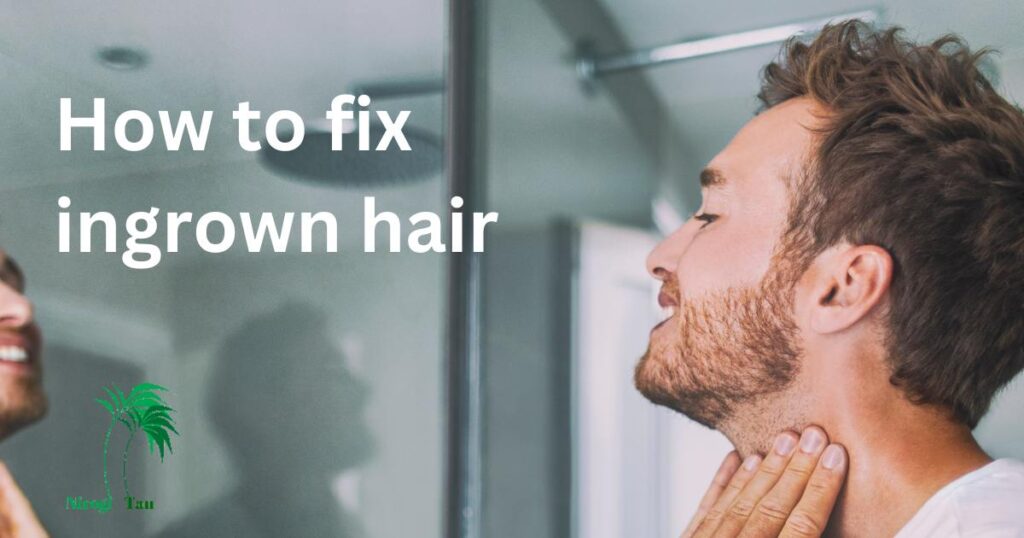Ingrown hairs are frequent and can be both painful and irritating. They develop as hair grows back into the skin, resulting in inflammation, redness, and occasionally infection. Although ingrown hairs can occur anywhere on the body, the legs, face, underarms, and bikini area are where they occur the most frequently. In this post, we’ll talk about the reasons why ingrown hairs form, how to avoid them, and how to treat them when they do.

Why do ingrown hairs occur?
Hair that grows back into the skin rather than out of it results in ingrown hairs. Several things can cause this to occur:
Curly or coarse hair:
Because these types of hair have a harder time penetrating the skin, they are more likely to develop ingrown.
Shaving:
Because shaving cuts the hair at an angle, it increases the likelihood that it may regrow into the skin and result in ingrown hairs.
Tight clothing:
Because it can press the hair back into the skin, wearing tight clothing might result in ingrown hairs.
Waxing:
Because waxing separates the hair from its root, which increases the likelihood that it will regrow into the skin, it might result in ingrown hairs.
Dead skin cells:
When hair follicles become clogged with dead skin cells, the hair may begin to grow back into the skin.
Ingrown hair prevention
The easiest approach to avoid having to remove ingrown hairs is to prevent them. The following advice can help avoid ingrown hairs:
Exfoliate:
Regular exfoliation can help get rid of skin debris that might obstruct hair follicles. Utilise a mild exfoliator, but take care not to overdo it since this can irritate the skin.
Use sharp razor:
Use a sharp razor to cut the hair cleanly, which lowers the likelihood that it will grow back into the skin and avoid ingrown hairs.
Shave in the right direction:
Shave in the direction of hair growth to lessen the possibility of ingrown hairs because doing so lowers the likelihood of the hair growing back into the skin.
Avoid shaving too closely:
Close shaving causes the hair to be cut below the skin’s surface, which increases the likelihood that it will regrow into the skin and increase the likelihood of ingrown hairs.
Moisturise:
Regular moisturising can prevent ingrown hairs by keeping the skin moisturised and healthy.
Wear loose clothing:
Because loose clothing avoids friction and allows the hair to grow freely, it can help prevent ingrown hairs.
Apply a warm compress:
Warm compresses can be used to soothe irritated skin and lessen inflammation. Simply use a clean washcloth for a few minutes to the affected area after wetting it with warm water and wringing away the excess.
Avoid using too much pressure:
When shaving or hair removal because doing so increases the risk of ingrown hairs. Let the razor or other hair removal device do the work with a light touch.
Think about using an electric razor:
By pushing the hair up and away from the skin, using an electric razor can assist to prevent ingrown hairs. This can lessen the possibility of hair being caught under the skin.
Avoid shaving too frequently:
By irritating the skin, shaving too frequently increases the risk of ingrown hairs. Ingrown hairs are less likely to occur if hair is allowed to grow for a few days after shaving.
Use creams:
Use shaving cream or gel to lubricate the skin and lessen the likelihood that hair will get caught under the skin. To avoid irritation, look for a product that is moisturising and gentle.
Take into account laser hair removal:
If you frequently get ingrown hairs, you might wish to think about laser hair removal. Ingrown hairs are less likely to occur thanks to permanent hair growth reduction provided by laser hair removal.
Steer clear of strong chemicals:
Chemicals that are harsh, including those in hair removal treatments, can irritate the skin and increase the likelihood of ingrown hairs. If you are prone to ingrown hairs, stay away from utilising these items.
Take care of your skin:
Hydrating and caring for your skin can help to prevent ingrown hairs. To keep your skin looking and feeling its best, eat a balanced diet, stay hydrated, and get enough rest.
In general, taking care of your skin and being gentle with it will help prevent and treat ingrown hairs. You may avoid ingrown hairs and enjoy smooth, healthy skin with the proper method.
Fixing ingrown hairs
If you do experience ingrown hair, there are remedies you can try. Here are some recommendations for treating ingrown hairs:
Leave it alone:
Sometimes an ingrown hair may go out on its own without treatment. Leave the ingrown hair alone and allow it to grow out if it is not inflicting any pain or discomfort.
Warm the area with a compress:
Warming the region with a compress will help soften the skin and make hair removal simpler. Apply a washcloth that has been soaked in warm water to the afflicted area for ten to fifteen minutes at a time.
Use a sterile needle:
Try using a sterile needle to try to remove any hair that is visible under the skin. Use rubbing alcohol to sterilise a needle or boil it for 10 minutes. Without damaging the skin, use the needle to gently remove the hair out of the skin.
Use tweezers:
If the hair is close to the skin’s surface, you can carefully remove it from the skin by using a pair of sterile tweezers. To prevent infection, make sure the tweezers are clean and sterile before using them.
Don’t pick at it:
It’s crucial to avoid picking at an ingrown hair since this can irritate the skin and exacerbate the issue. Instead, use one of the aforementioned techniques to delicately coax the hair out of the skin.
Apply a topical remedy:
If the ingrown hair is making the region itchy or uncomfortable, you can apply a topical remedy to make the area feel better. Look for a product with salicylic acid or glycolic acid because they can aid in exfoliating the skin and releasing the hair that has become trapped.
Read more: Is a bagel with cream cheese a healthy breakfast
Consult a dermatologist:
If the ingrown hair is causing you a lot of pain or if it becomes infected, you should make an appointment with a dermatologist. To aid in the eradication of the infection and avoid scarring, they can recommend topical or oral medicines.
Scar prevention strategies
A scar may be left behind by an ingrown hair that was picked at or became infected. Here are some suggestions for avoiding scarring:
Avoid picking at the area:
Picking at the region might aggravate the skin’s condition and raise the likelihood of scarring.
Keep the area tidy:
To avoid infection, keep the injured area tidy and dry.
Apply a scar treatment:
If a scar does develop, you can do so to assist lessen its visibility. Look for a solution that contains silicone because research has shown that it works well to lessen the visibility of scars. If the scar is extremely prominent, you might want to think about laser treatment. Scarring can be less noticeable and the skin can be smoothed out using laser treatment.
Conclusion
Although ingrown hairs can be a pain and an annoyance, there are ways to avoid them and treat them. You can lessen your risk of developing ingrown hairs and treat them if you do by using the advice provided in this article. In order to minimise scarring, always remember to be gentle when removing ingrown hairs. Consult a dermatologist for guidance if you’re unclear of how to manage an ingrown hair or if it becomes infected.
FAQs
Use a warm compress to relax the skin and move the hair closer to the surface in order to draw out an ingrown hair. After a few minutes of applying a warm, damp cloth to the region, make a gentle attempt to remove the hair using a sterile needle or pair of tweezers. To avoid infection, make sure to clean the area both before and after removing the hair. If the hair is still stuck, don’t try to force it out because doing so may irritate the area even more and leave scars. Instead, keep using warm compresses and watch for the hair to come out on its own.
An ingrown hair should not be pulled out. The damaged region may become even more irritated, inflamed, or even infected if you pop or squeeze it. Additionally, it may force the hair deeper into the skin, making removal more challenging. If you must remove the hair, it is best to do it cautiously and delicately using a sterile needle or pair of tweezers, cleaning the area both before and after. Warm compresses can also aid in luring the hair to the surface where it will be simpler to remove. Get medical help if the area becomes infected.

Dr. Shraddha S. Chouhan is here. I’m an Indian dentist. I’m currently wrapping up my internship. I fell in love with human body health and its various aspects while working in the medical field, beginning with science. During my final year of dental school, I began practising yoga and learning about organic food, a healthy lifestyle, and the benefits it has on our human bodies. Learning more about organic food and its importance to our health has astounded me. Now I’m on a mission to learn more about healthy eating, living, and organic food.

